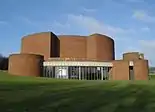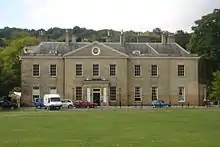Arundel Terrace
Arundel Terrace is a road in Kemp Town, Brighton containing 1–13 Arundel Terrace, a row of Grade I listed buildings; numbers 12–13 are known as Arundel House. The buildings were built between 1824 and 1828 by Amon Wilds and Charles Busby.
| Arundel Terrace | |
|---|---|
_(December_2016)_(4).JPG.webp) The terrace seen from the southeast | |
| Location | 1–13 Arundel Terrace, Kemp Town, Brighton and Hove, United Kingdom |
| Coordinates | 50.8151°N 0.1091°W |
| Built | 1824–1828 |
| Built for | Thomas Read Kemp |
| Architect | Amon Wilds and Charles Busby |
| Architectural style(s) | Regency |
Listed Building – Grade I | |
| Official name | Nos. 1–13 (Consecutive) Arundel Terrace |
| Designated | 13 October 1952 |
| Reference no. | 1379917 |
 Location within Brighton and Hove | |
History
The Arundel Terrace houses were built for Thomas Read Kemp by Amon Wilds and Charles Busby between 1824 and 1828.[1] All were constructed with Doric porches and ironwork balconies, although not all these remain, and the buildings were built facing the sea.[2][3] They were built as part of a 106 house development plan for the Kemp Town area of Brighton.[4]
Number 13 was the first building to be completed, and was used from 1826–1851 as the Bush Hotel, before being put up for sale by the building's owners, a Mr Creasy and Mr Wilkinson.[1][3][5] The building was then converted into a private house, and then a girls' school.[2] In 1910 it became a nursing home, and in the 1950 it was converted into a guest house.[1][3] Number One was the home of lawyer and financier Chevalier François de Rosaz; in his will, de Rosaz asked for the building to be converted into a Catholic asylum.[2][1] Number 5 has had a string of interesting owners and residents. From 1853-57, it was the home of writer William Harrison Ainsworth; during his time living at 5 Arundel Terrace, he wrote the novels The Star Chamber, The Flitch of Bacon, The Spendthrift, The Life and Adventures of Mervyn Clitheroe, and Ovingdean Grange.[1][3] A plaque outside commemorates Ainsworth.[6] Number 5 was also the home of the painter Count William de Belleroche, son of the pioneer of lithography, Albert de Belleroche; broadcaster Annie Nightingale (1964-67); writer and Second World War Royal Air Force hero Paul Richey (1967-73); and it has been the home of journalist Roy Greenslade since 1973. Actor Robert Flemyng lived at Number 6 from 1949 until his death in 1995. He let the ground floor to West End theatre star Douglas Byng from 1974 until his death in 1987; his ashes were scattered outside the buildings.[1][7] Ronald Searle, the cartoonist and creator of St Trinian's School, lived at Number 8, 1958-64. The playwright and screenwriter John Osborne lived at Number 7 (1948-49), as did John Henson Infield, the proprietor of the Evening Argus and Sussex Daily News (1920-38)[1] and Edward FitzGerald, the 7th Duke of Leinster (1966-70). Actor and singer Millicent Martin lived at Number 8, 1970-73.
Number 11 is listed as being put up for sale as an eleven bedroom private house in 1844,[8]
In 1952, the Terrace, including Arundel House (which is listed as being numbers 12–13 Arundel Terrace), became a Grade I listed building.[9] In 2015, Arundel Terrace was included in plans made for a proposal for Brighton Promenade to become a UNESCO World Heritage Site.[10]
References
- "The streets of Brighton & Hove". Brighton History. Retrieved 15 May 2016.
- Page, Thomas (1864). Folthorp's Court Guide And General Directory For Brighton, Hove, And Cliftonville. p. 55. Retrieved 15 May 2016.
- "Development of Kemp Town". My Brighton and Hove. Retrieved 15 May 2016.
- "A Brief History of Kemp Town". Kemp Town Online. Retrieved 15 May 2016.
- "Kemp Town". Brighton Gazette. 30 January 1851. p. 1. Retrieved 15 May 2016 – via British Newspaper Archive.
- "Blue Plaques". Visit Brighton. Retrieved 15 May 2016.
- Pearce, Lucy (5 December 2015). "Nostalgia: The Sussex celebrities who made Brighton their home because of its tolerance". The Argus. Retrieved 15 May 2016.
- "Kemp Town". Brighton Gazette. 9 May 1844. p. 1. Retrieved 15 May 2016 – via British Newspaper Archive.
- Historic England. "Arundel House (1379917)". National Heritage List for England. Retrieved 15 May 2016.
- "World Heritage status 'well worth' applying for, say officials in Wales and Derbyshire". The Argus. 19 September 2015. Retrieved 15 May 2016.


.jpg.webp)


.jpg.webp)

